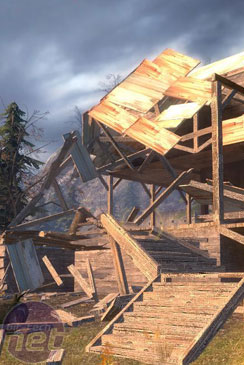
What’s Pretty?
Now we come to the graphics because, when all is said and done, everybody still wants their games to look nice. It’s a sad fact when it gets in the way of gameplay, but it’s also true and there’s no real harm in wanting a game to look pretty.Now, the problem is that Episode Two is built on the Source Engine, which is the same engine that all the Half-Life games have run on since Counter-Strike: Source. This means there isn’t really anything new to see in terms of visual quality and AA, etc. Everything looks a little crisper and nicer thanks to the 'very high' texture quality setting, but that’s about it.
In fact, the graphics options available are exactly the same as in Team Fortress 2.
So, instead of looking at the same old stuff again, we’re going to show off the two main enhancements to the Source Engine that are specific to Episode Two – wide-open levels and cinematic physics. It was back in November last year when we first had a look at how Valve was going to implement physics into the Source Engine during a trip over to the developer's offices in Bellevue, Washington State.
Let’s have a look at how that's worked out then, shall we?
Cinematic Physics
Physics has been a bit of a hot-topic the last few years, mainly after the gravity gun first appeared in Half-Life 2 and everybody decided it was the best thing since the breadknife. Soon, Garry’s Mod arrived and started showing everyone what could be done with the Havok engine.At the same time, companies like Ageia were unveiling physics cards and stating that they were pivotal to the future of gaming. The truth of that has yet to be seen and the physics overhaul in the Source Engine won’t do anything to help Ageia out, I’m sure.
Just check out these screenshots, all of which we saw without a single drop in frame rate - we're using a dual-core CPU here for reference purposes, and we'll be looking into multi-core scaling in Episode Two in an upcoming CPU review. Towards the end of the game there are a series of large battles, obviously, and explosions like these are a dime a dozen.
There’s no option to turn these physics on or off – they are just there in all possible splendour.
Wide-Open Spaces
If there was one thing which united those who played Half-Life 2 it was the burning desire to know who the hell the G-Man was. If there was a second thing to unite them it would be a near universal annoyance at the limited level size allowed in the Source Engine, which prevent massive spaces from being a possibility.Through some rather inventive engine tweaking, Valve has managed to remedy this problem and create some maps which are a little larger. The type of large which those naughty spam e-mails keep promising me. Loading between the levels still takes a moment or two, but for us it was no longer than the load times were in the original Half-Life 2 and they are much fewer and farther between.

MSI MPG Velox 100R Chassis Review
October 14 2021 | 15:04













Want to comment? Please log in.